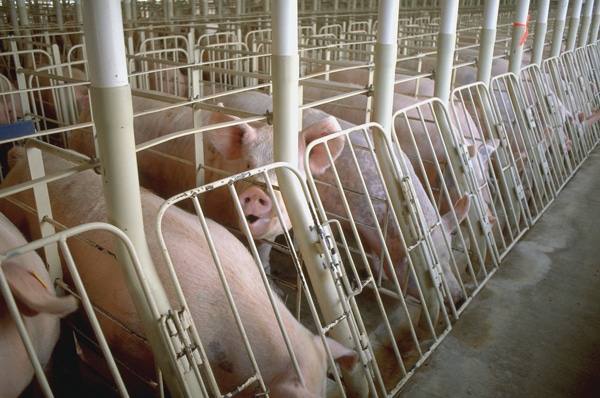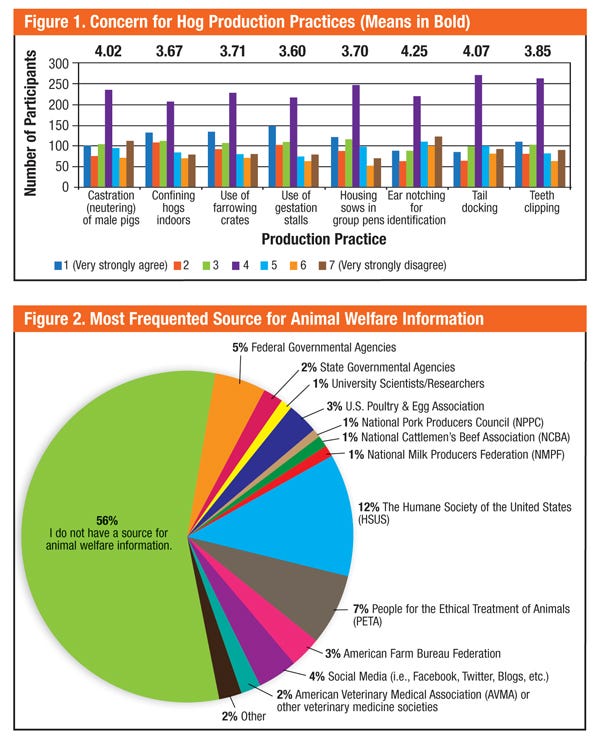Consumer Survey Outlines Pork Perception Issues
In an effort to gauge consumer perceptions of livestock production, Purdue University’s Department of Agricultural Economics and Depart­ment of Animal Sciences conducted a consumer survey last summer. The survey of 798 participants from a nationally representative sample collected information regarding livestock product purchasing characteristics, perceptions of pig welfare and sources of animal welfare information.
December 15, 2012

In an effort to gauge consumer perceptions of livestock production, Purdue University’s Department of Agricultural Economics and Department of Animal Sciences conducted a consumer survey last summer.
The survey of 798 participants from a nationally representative sample collected information regarding livestock product purchasing characteristics, perceptions of pig welfare and sources of animal welfare information.
Regarding familiarity with livestock production, participants were asked when they last visited a farm that raised animals for meat, milk or egg production. Only 31% had visited such a farm within the last five years. Nearly one-third of participants had never visited such a farm.
When asked to rank hog industry segments from most concerned to least concerned about pig welfare, average rankings were: 1) processors, 2) farm production, 3) transportation and 4) auction markets.
Participants were also asked about their opinions regarding specific production practices (Figure 1). For most production practices, those surveyed had a neutral attitude. Housing sows in group pens, use of farrowing crates, use of gestation stalls and confining hogs indoors had the lowest means, indicating the participants felt these practices reduced pig welfare the most.

Purdue researchers speculated that housing practices may have generated the most responses from consumers because most media have focused on housing as a pig welfare issue of
concern.
Castration and tail docking had the highest means, indicating the least concern for pig welfare. It is possible respondents didn’t associate these practices with lowering pig welfare because they might be most familiar with these practices that are common for household pets.
Consumer sources of animal welfare information were also surveyed. Nearly 75% of consumers reported that they had not seen media stories regarding pig welfare. The two most common media sources were the Internet and television; 21% of respondents reported having seen pig welfare stories from each of these sources. Only 8% reported having seen pig welfare stories in printed newspapers and magazines and only 5% had read about pig welfare in books.
Most agriculturalists view themselves as knowledge experts for animal welfare; however, this study found that consumers frequented other sources for such information.
When asked which sources they frequented the most, they cited the Humane Society of the United States (HSUS) and the People for the Ethical Treatment of Animals (PETA). In fact, more people turned to the HSUS and PETA for animal welfare information than industry groups, government agencies and scientific sources combined (Figure 2).
Moreover, 56% of respondents indicated that they did not have a source for animal welfare information.
Fourteen percent of consumers stated that they had reduced pork consumption by an average of 56% from their previous consumption over the past three years due to animal welfare concerns.
The researchers declared: “These statistics should lead to questions about the effectiveness of communication between agricultural industries and consumers. Why are animal protection groups more successful at connecting with consumers?”
Researchers: Melissa G. Short McKendree, Nicole Olynk Widmar and Candace Croney, Purdue University. For more information, contact Widmar by phone (765) 494-2567, fax (765) 494-9176 or e-mail [email protected].
You May Also Like



